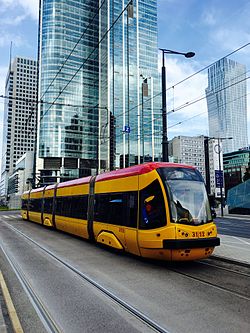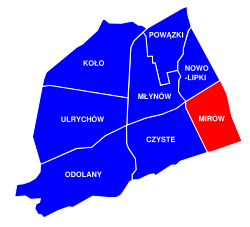Mirów, Warsaw
Mirów | |
|---|---|
Warsawneighbourhood | |
 Tram on Prosta Street | |
 Location of Mirów neighbourhood (red) in the District ofWola(navy blue) | |
| Coordinates:52°13′56″N20°59′28″E/ 52.23222°N 20.99111°E | |
| Country | |
| Voivodeship | Masovian |
| County/City | Warsaw |
| District | Wola |
| Time zone | UTC+1(CET) |
| • Summer (DST) | UTC+2(CEST) |
Mirów(Polish pronunciation:[ˈmiruf]) is one of the central neighbourhoods in theWoladistrict ofWarsaw,the capital ofPoland.
History
[edit]The neighbourhood is situated between Towarowa Street to west, Solidarity Avenue to the north, John Paul II Avenue to the east andJerusalem Avenueto the south. The principal thoroughfare of the area is Prosta Street.
18th century
[edit]The present-day territory of Mirów was once occupied by ajurydykacalled Wielopole,[1]a self-governing town and exclave of Warsaw, just outside the city's borders.[2]By the 18th century, the town lost its independent status and was incorporated into the city limits.[3] The area was named after William Mier, aScottishofficer in Polish service and the commanding officer of theHorse Guard of the Polish Crown Regimentstationed in what became known as the Mirów Barracks.[4]The barracks and stables were completed in 1732.
Contemporary
[edit]
Much like the rest ofWola,Mirów was an industrial suburb inhabited by the working classes until theFirst World War.In the early 20th century and during theinterbellumperiod (1918–1939), it was gradually redeveloped with large houses and tenements, characteristic to the big capitals of Europe. Following theWarsaw Ghetto Uprisingand theWarsaw Uprisingmost of the area was razed to the ground by the Germans. After the war it was not rebuilt, and instead a largetower blockresidential estate withSoc-Realistbuildings was constructed which was to meet the house supply shortages for the incoming new residents from other parts of Poland. At the easternmost tip of Mirów, atPlac Żelaznej Bramythere are twoMirów Marketplace Hallswhich were only partially damaged and later renovated for commercial use.
Contemporary Mirów has undergone a major transformation and is now primarily a commercial neighbourhood, with office buildings and skyscrapers abundant within its borders.
